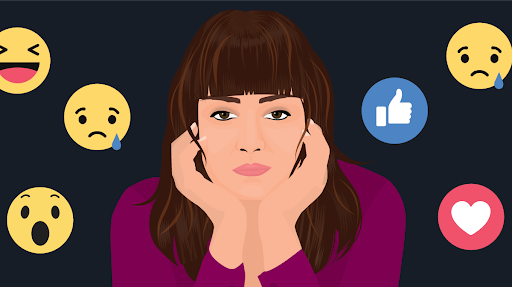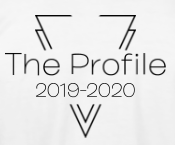How Social Media Influences the Mental Health of Women

February 25, 2022
The growth and expansion of social media has been on the rise ever since 1997 when Six Degrees came out as the very first social media platform. It allowed users to create profiles, meet new friends, and have social interactions with each other over the computer. Now we have numerous platforms such as Instagram, Facebook, Snapchat, and Twitter where people across the world can connect, share, and like each other’s feeds and posts. In 2022, the world has come to the realization that social media is not just used for what we call “positive” input, there are so many more underlying issues such as bullying and photoshop, which create ideals such as the false body image for women and young teens’ mindsets. These major underlying issues lead to severe mental health issues, such as depression, anxiety and eating disorders and they have a major correlation with the mental health of women.
Over the past years society has seen a huge increase in the use of social media, especially in younger audiences. Young girls in their adolescence and even their young adulthood have a strong connection to social media platforms and are seeking attention and validation for likes and shares, especially on the well known platform: Instagram. For those unfamiliar with Instagram, Instagram is a platform owned by Facebook that allows audiences around the world to post pictures and share pictures of themselves and their adventures on a public or private feed. From there, followers can like and share a person’s posts. This is where the problems begin. Instagram is one of the number one platforms where bullying and photoshop is a major issue. In particular, Instagram models and influencers take heavy into photoshop, skewing their images a bodys to make them look “skinnier” and more “feminine”. This is where the ideal of a perfect body image starts. According to Kim Elsesser, a writer for Forbes Magazine in an interview with Jennifer Mills, a Psychologist at York University states, “I was hearing patients and students talk about how they felt about social media, and the pressure they felt to look a certain way based on comparing themselves to what other people posted”.
In addition, eating disorders have heightened because of social media due to the false body image ideals that it presents to its audiences. Mills also states, “I was hearing from clients with eating disorders that they would see pro-anorexia content in their feeds and felt compelled to follow those types of accounts, even when they knew that it was very bad for their health”. This can be further explained in a study conducted by the National Health and Medical Research Council in 2020 called “Protect me from my Selfie”. This study looks at the results of the self-report photo investment and manipulation scales completed by teen girls, and results in a significant correlation between eating disorders and the posted selfies on social media platforms. Researchers found that, “Eating disorders were identified by the Eating Disorder Examination Questionnaire and other self-report measures aligned with diagnostic and statistical manuals for mental disorders-5 criteria”. Thus was taken by 53.15% of Australian teen girls and found that these girls on social media looking at others’ selfies and posts are linked to eating disorders.
As far as concerns of the health and well being of these young women, eating disorders are the top mental illness that is caused by social media. The drive for “thinness” is on the rise and these younger audiences are trying to match the expectations of the fitness bloggers and instagram models. According to the Clementine Project, an organization that helps adolescents recover from eating disorders (2016), there are multiple factors in social media that can cause eating disorders, especially in adolescence . Social media creates an image that is almost impossible for teenage girls and even adult women to follow. The prolonged hours that young girls and women spend on social media become sickening ones. About 43% of teenage girls feel bad about themselves, just because their posts did not get enough likes or comments, and as a result they deleted posts due to embarrassment and discomfort. (The Clementine Project) The Clementine Project also argues that “These teens are constantly seeking approval and ways to feel better about themselves as it is, so this added pressure can easily trigger disordered eating behaviors as they try to achieve an impossible standard”. Moreover this study found a strong link between consistent social media use and negative body image issues including dieting, self-objectification, and body surveillance.
However, eating disorders are not the only mental illness at risk. Depression and anxiety have seen an increase since social media has become a part of everyday life. On average, society accesses social media via phone or tablet. While this might be great for communication and keeping in touch, it also means that social media is constantly available at consumers’ finger tips. According to HelpGuide, “When you receive a like, a share, or a favorable reaction to a post, it can trigger the release of dopamine in the brain, the same “reward” chemical that follows winning on a slot machine, taking a bite of chocolate, or lighting up a cigarette”.
While social media companies claim to have some benefits in the lives of users, these sites may cause more harm than good when it comes to the onset of psychological disorders. Spending too much time on social media can cause a sense of loneliness, isolation, frustration, sadness and dissatisfaction (Help Guide). Humans need face-to-face connection in order to gain psychological benefits and ironically, while social media has the idea to bring others closer it simply can’t do so. This type of psychological disconnect that social media creates is not the only factor in the formation of depression and anxiety. Cyberbullying plays a huge factor in online interaction. HelpGuide also states, “About 10 percent of teens report being bullied on social media and many other users are subjected to offensive comments. Social media platforms such as Twitter can be hotspots for spreading hurtful rumors, lies, and abuse that can leave lasting emotional scars”.
Not only do researchers understand the negative societal effects these social media platforms have, but the creators and managers of the most widely used social media sites have been aware of their company’s negative influence for quite awhile. In 2020 a whistleblower inside of facebook leaked communication between facebook employees. This leaked communication pointed to a culture of dismissal within the complay in regards to research about their platform’s role in the mental health of adolescents. According to the Wall Street Journal, “For the past three years, Facebook has been conducting studies into how its app Instagram affects its millions of young users. Repeatedly, the company’s researchers found that Instagram is harmful for a sizable percentage of them, most notably teenage girls”. However, Facebook has been pushing these issues under the rug, so they don’t arise to the public eye. Facebook not only has denied the allegations but publicly they have stated that their apps don’t have serious effects on young women.
Emma Chamberlain, a popular social media influencer, talks on her podcast, Anything Goes, about her personal experience with fitting into the “feminine mold” created by the influence from others, society and social media. Societal norms for people, especially women, have created expectations of appearance and experience that they are pressured to abide by in order to fit a certain standard. social media projects these expectations in images of others regarded as the example. Those who cannot meet the expectations are placed beneath those who can and the bullying takes place. In this podcast, Chamberlain specifically talks about the instances when she was younger where she was motivated to dress a certain way or act a certain way to gain attention from peers and fit the “feminine mold”. The pressure she felt, she notes, was definitely not a positive influence on her mental health. “Who is there to define what a stereotypical woman is; movie stars, influences, people that are popular on social media,” Chamberlain states, “Those are the people that everyone pays attention to.”
Social media has significant influence on the social norms for many young women and the main distributor is the few creators who can project a level of carefully crafted and staged perfection that is unreachable to the average person. Furthermore, in another podcast titled Empty Inside, Jennete McCrudy, an actress best known for her role as the tough and tomboy styled Sam from the 2000’s tv show ICarly, McCurdy recalls that she was also influenced by social media and Hollywood in general to fit the “perfect” stereotype that is presented by social media. Her experience with social pressure on social media, along with the pressure of being a public figure herself, led to her eventual development of an eating disorder in her late teenage years.. In her podcast McCurdy states, “That’s the idea that social media puts out there is that you have to be small in order to be pretty”. This is the root of where the sickening effects of social media begin.
It can be argued that social media has many positive effects, such as an extended amount of communication to others, the ability to meet new people and get involved in important social and world issues, and share expertise in creative outlets and methods of self-expression. However, the undeniable negative effects on mental health and social interaction can be long term and detrimental to young girls and women leaving researchers, lawmakers, and parents wondering if mental health is too much to risk just to be part of a social trend.

